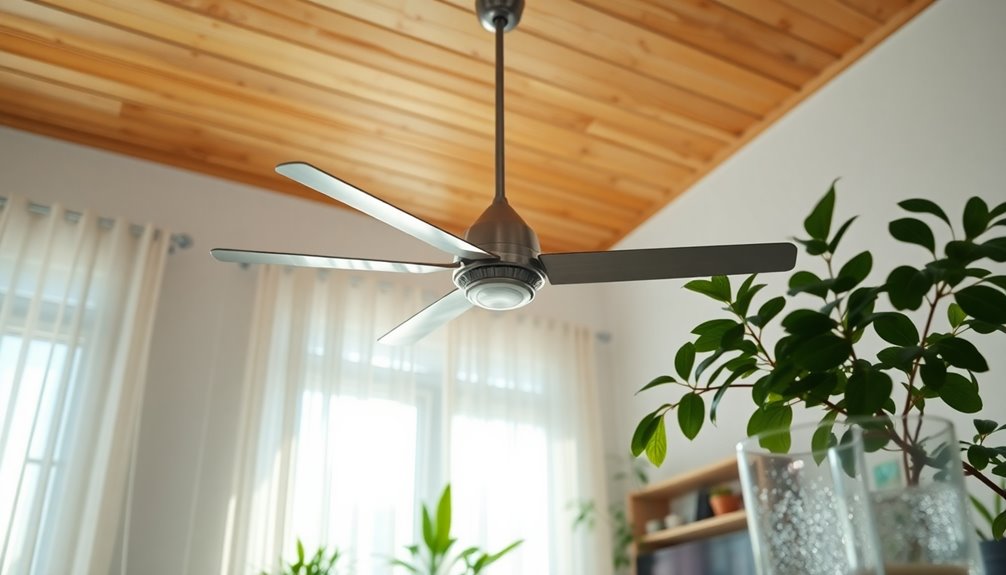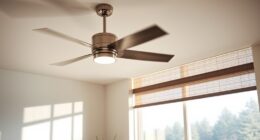Ceiling fan blades aren't universal, so it's vital for you to check compatibility with your specific fan model. Blade size and mounting systems vary, which means that using mismatched blades can lead to performance issues or even damage. Typically, you'll find common sizes range from 21 to over 60 inches. Always measure from tip to tip to find the right replacement size. Additionally, the materials and designs you choose can impact both functionality and aesthetics. Understanding these factors guarantees you select the best blades for your needs, and there's much more to explore on keeping your ceiling fan in top shape.
Key Takeaways
- Ceiling fan blades are not universally compatible; they vary in size, mounting systems, and hole spacing across different models.
- Replacement blades must match the original blade size and mounting configuration to ensure proper fit and performance.
- Some universal blades may require modifications, such as drilling new holes, for alignment with specific fan models.
- Materials and designs of blades differ, affecting aesthetics and functionality; choose blades that suit your fan's specifications.
- Always consult the fan's manual for compatibility and recommended replacement options to avoid performance issues.
Understanding Ceiling Fan Blades

When it comes to understanding ceiling fan blades, it's vital to recognize that they come in various sizes and designs. You'll often find blades ranging from 21 to over 60 inches, with 42-inch and 52-inch blades being the most common. This variety in blade size impacts not just aesthetics but also the fan's performance and airflow.
When you need to replace your ceiling fan blades, you might think about universal options. While some replacement ceiling fan blades are designed to fit most standard blade arms, it's important to remember that most fans require specific mounting systems. This means compatibility isn't guaranteed, even with universal blades.
Moreover, the attachment points connecting the blades to the motor and housing can differ greatly between models. You may find that replacement blades come with pre-drilled holes, but you might still need to drill new holes for proper alignment with your fan's mounting system.
Always check the specifications of your fan before purchasing to make sure you choose the right blade size and type, avoiding unnecessary hassle during installation.
Factors Affecting Compatibility

Replacing ceiling fan blades isn't as straightforward as picking up a set labeled "universal." Several factors affect compatibility, primarily due to differences in mounting systems and blade arm configurations among various fan models and brands.
When you need to replace your blades, keep these key elements in mind:
- Mounting System: Most fans use a 3-hole system, but the distance between holes can vary greatly.
- Blade Size: Replacement ceiling fan blades typically come in sizes like 42-inch and 52-inch. Sticking to the original size is vital to avoid motor stress.
- Modifications: Some replacement blades might require drilling new holes, which complicates the installation.
Before purchasing replacement blades, it's important to check your fan's manual or specifications to verify compatibility.
An improper fit can lead to safety hazards and reduced performance, so don't overlook this step.
Measuring Blade Size

Measuring the size of your ceiling fan blades is vital for finding the right replacement. Start by safely accessing the blades using a ladder or step stool. Carefully remove one blade with a screwdriver to measure its length accurately. Verify you're measuring from tip to tip, as this gives you the correct size for your replacement fan blades.
Most ceiling fan blades come in standard sizes, typically 42 inches or 52 inches, so it's important to check for compatibility with your specific fan model. You can refer to the fan's manual, box, or warranty for the exact blade dimensions. This will help you confirm what size you need for your replacement options.
When replacing fan blades, it's advisable to use blades that match the original size. Doing so avoids stressing the fan motor, guaranteeing peak performance.
You'll want to maintain the balance and efficiency of your fan, so accurate measuring blade size is key. By taking these steps, you can confidently select the right replacement fan blades that fit your ceiling fan perfectly!
Types of Replacement Blades

When choosing replacement blades, you'll find a range of materials like wood, plastic, and metal, each offering unique looks and durability.
It's important to take into account design compatibility, as not every blade fits every fan model.
Make sure to verify your fan's specifications to guarantee a perfect match.
Material Options Available
Choosing the right material for your ceiling fan blades can greatly impact both the aesthetic and functional aspects of your space. When considering replacement blades, you have several options that cater to different styles and needs:
- Bamboo: Eco-friendly and stylish, available in composite and natural finishes.
- Wood: Offers classic finishes like walnut and oak, perfect for traditional decor.
- Plastic: Durable and ideal for outdoor settings, resisting the elements.
Each material brings its own unique benefits to your ceiling fan. Bamboo blades not only look great but also contribute to sustainability.
Wood blades offer timeless elegance, enhancing the charm of your interior. If you're looking for something more resilient, plastic blades hold up well in varying weather conditions.
For a modern vibe, consider metal blades like polished nickel, which provide both sleek design and durability.
Design Compatibility Factors
A variety of factors influence the design compatibility of replacement ceiling fan blades. While many replacement fan blades offer a universal fit, you'll find that compatibility can vary considerably based on your specific fan model and its mounting system.
Pay special attention to the blade arm configurations, as this can determine if the new blades will fit seamlessly. Most replacement blades come with a patent-pending universal blade mount system that works with standard 3-hole blade arms.
However, it's essential to check if the blades are pre-drilled for mounting screws. In some cases, you might need to make modifications for a proper fit.
The size and shape of the replacement fan blades can greatly affect your ceiling fan's overall performance. To maintain efficiency, verify the new blades match the original dimensions and design of your fan.
Additionally, consider specialty designs that use various materials like wood, plastic, or metal. These materials not only affect compatibility but also determine the suitability for indoor or outdoor environments.
Installation Process Overview

To begin the installation process of ceiling fan blades, you'll want to gather your tools and ascertain safety by using a sturdy ladder. Before you start, make certain to check the manufacturer's specifications to confirm compatibility with your fan model.
Here's an overview of the key steps:
- Remove existing blades: Use a screwdriver to take out the screws holding the old blades in place.
- Clean the fan and housing: Wipe down the fan blades and housing to enhance visibility and guarantee proper operation.
- Install new blades: Attach each new blade one at a time, securing them with the original screws or new ones if included. Make sure to choose blades that are designed for optimal airflow to enhance cooling efficiency.
As you install the ceiling fan blades, double-check for alignment and stability. If you're using universal blades, be prepared for possible modifications like drilling new holes. Keep in mind that ensuring proper suction power is crucial for maximizing airflow efficiency in your fan.
Following the included directions closely is vital for a successful installation. Once everything's securely in place, you can enjoy your refreshed ceiling fan, knowing you've completed the installation process correctly!
Performance Considerations

After you've installed the ceiling fan blades, it's important to contemplate how their performance will be affected by various factors. Not all replacement blades are interchangeable, so you should always verify compatibility with your specific fan model before making a purchase.
The performance of your ceiling fan hinges primarily on the motor's efficiency rather than the blade size. To maintain balance and prolong the motor's lifespan, stick to blades that match the original size.
While larger blades can increase airflow, they may also put extra strain on the motor, which could reduce its efficiency over time. Selecting replacement blades according to the manufacturer's specifications is essential for peak performance. This helps prevent wobbling or instability during operation, which can detract from the overall effectiveness of your fan.
Proper alignment and secure attachment of the blades are also critical. Even slight misalignments can lead to decreased airflow and increased noise, undermining your efforts for a comfortable environment.
Material Variations

What materials do you prefer for your ceiling fan blades? The variety of material types available for ceiling fan replacement blades can greatly impact both durability and the overall look of your fan.
Here's a quick rundown of some popular options:
- Wood: Classic finishes like walnut and oak add warmth to any room.
- Plastic: Perfect for outdoor use, these blades resist weather conditions and are easy to maintain.
- Bamboo: An eco-friendly choice, bamboo blades come in both composite and natural finishes, providing a lightweight and stylish option.
You might also consider metal blades if you want a modern touch. Polished nickel finishes offer a sleek look and are often more resistant to wear and tear compared to traditional wood or plastic options.
Specialty designs, like carved wood or wicker finishes, can cater to diverse tastes, enhancing your room's decor.
When choosing your ceiling fan replacement blades, think about the material types that best fit your needs and style preferences. Each option has its unique benefits, so weigh your choices carefully to find the perfect match for your space!
Aesthetic Enhancements

A ceiling fan's aesthetic appeal can transform a room, making it a key element in your home decor. With a wide range of replacement fan blades available, you can easily find styles that match your personal taste, whether you prefer traditional, modern, or rustic designs. These aesthetic enhancements allow you to seamlessly integrate your fan into any space.
Materials play a significant role in the visual impact of your ceiling fan. Wood, metal, and acrylic options each provide unique looks and durability. Clear acrylic blades, for instance, offer a sleek, contemporary vibe while resisting warping.
Customizable designs—like carved wood or wicker finishes—can add character and serve as striking focal points. Additionally, incorporating natural materials in your ceiling fan design can enhance its rustic charm and complement a modern farmhouse aesthetic.
Color variations also enhance your design options. From rich dark wood tones to shiny metallic finishes, you can switch styles effortlessly, revitalizing your decor without the hassle of a full fan replacement.
If you're looking to create an inviting outdoor setting, specialty blade designs like tropical palm fronds add a decorative touch while maintaining functionality in various weather conditions.
Embrace these aesthetic enhancements to elevate your ceiling fan and overall room ambiance.
Maintenance and Care

To keep your ceiling fan running smoothly and looking great, regular maintenance is key. You'll want to develop a routine that focuses on several essential tasks.
First, make certain to maintain cleanliness by regularly dusting the blades. A microfiber cloth or vacuum attachment works wonders to prevent dust buildup, which can affect air quality and efficiency.
Next, it's vital to inspect fan blades periodically for any signs of damage. Look out for:
- Cracks or warping
- Loose screws or mounting hardware
- Corrosion, especially for outdoor fans
Additionally, don't forget to check the fan motor's lubrication and blade alignment. Proper lubrication enhances operational efficiency and reduces noise, making your fan more enjoyable to use.
Confirm that all screws and mounting hardware are tight and secure to prevent wobbling and potential damage.
Choosing the Right Brand

When you're choosing replacement blades, brand compatibility is essential to guarantee a proper fit and function.
Different brands offer various material qualities and aesthetic options, so it's worth comparing them to find the best match for your fan and decor.
Always check the manufacturer's specifications to avoid compatibility issues down the line.
Brand Compatibility Factors
Selecting the right brand for ceiling fan blades is essential for ensuring compatibility and performance. You need to remember that not all brands and models are created equal. Each may have specific design requirements and mounting systems that influence how well replacement blades fit your fan.
When choosing replacement blades, consider the following factors to maintain brand compatibility:
- Manufacturer's Specifications: Always check the guidelines provided by the manufacturer for your existing fan model.
- Size and Material: Match the dimensions and construction type of the new blades with your original ones for ideal airflow and aesthetics.
- Custom Options: Some brands offer custom blade sets tailored for specific fan models, enhancing both functionality and look.
While many brands, like STAUBER, provide universal replacement blades designed for standard 3-hole blade arms, modifications might still be necessary for certain types of fans.
Ensuring you select the right brand won't only keep your ceiling fan running smoothly but also enhance its overall appearance.
Material Quality Comparison
Choosing the right material for ceiling fan blades can greatly impact both performance and aesthetics. When you're in the market for replacement blades, consider the material quality, as it varies considerably among brands. Solid wood blades offer a classic look but may require more maintenance, while composite and high-density plastic options often provide durability at a lower cost.
Premium brands like Fanimation and Kichler stand out for their superior material quality and finishes, which can elevate the overall design of your fan. While these blades can range from $37.95 to $283.48, the investment often pays off in longevity and style.
If you're after a modern aesthetic, acrylic blades, like those from STAUBER, are worth considering. They're resistant to warping and rotting, making them suitable for both indoor and outdoor use.
Don't forget to check the warranty and customer support offered by the brand, as well as feedback from other users. This can give you insights into the ease of installation and the performance you can expect, which varies widely among manufacturers.
Choose wisely to guarantee you get the best value for your ceiling fan upgrade.
Frequently Asked Questions
Can You Swap Ceiling Fan Blades?
Yes, you can swap ceiling fan blades, but it's essential to guarantee they fit your specific fan model.
You'll want to match the size and mounting system to avoid any issues. Choose blades that align with the attachment points to prevent wobbling.
While replacing blades can improve the look and performance of your fan, always verify compatibility to maintain airflow efficiency and avoid stressing the motor.
Enjoy customizing your space!
Are All Ceiling Fan Blades the Same?
Not all ceiling fan blades are the same, and thinking they're is like believing every tree grows the same way!
You'll find blades in a variety of sizes, materials, and designs, each tailored for specific fan models.
If you need to replace yours, you can't just grab any blade off the shelf.
Always check for compatibility with your fan's model and mounting system to guarantee everything fits and functions perfectly!
How Do I Know What Size Ceiling Fan Blade I Need?
To determine the size of the ceiling fan blades you need, measure the length of your existing blades or check the fan's manual for specifications.
Most replacement blades range from 42 to 52 inches. It's best to replace them with the same size to avoid stressing your fan motor.
Make sure the new blades are compatible with your fan model, as some brands might've unique requirements.
Always use a ladder for safe access!
Do All Ceiling Fans Fit the Same?
Not all ceiling fans fit the same. Each fan model often has specific requirements for size and mounting.
When you're looking to replace or upgrade your fan, you need to check the dimensions and compatibility of the blades with your fan's motor. Some blades might seem similar, but attachment points can differ widely between brands.
Always consult your fan's manual or box to verify you're making the right choice for a proper fit.
Conclusion
To sum up, while not all ceiling fan blades are universal, many can fit a variety of fans with the right measurements and compatibility. Did you know that over 75% of households in the U.S. have at least one ceiling fan? That means there's a good chance you'll encounter different blade styles and sizes. Choosing the right blades can enhance your fan's performance and look, so keep these factors in mind to make an informed decision!









